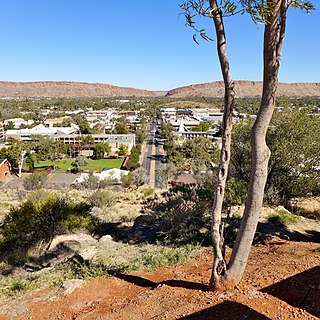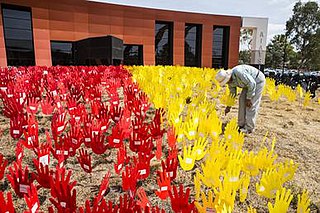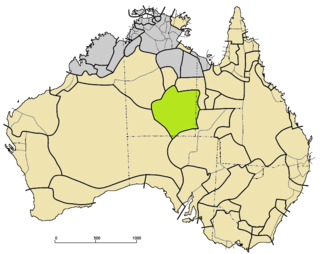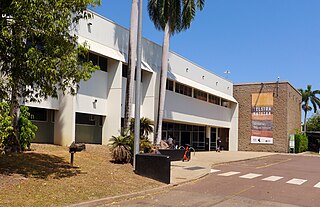
The Northern Territory is an Australian internal territory in the central and central-northern regions of Australia. The Northern Territory shares its borders with Western Australia to the west, South Australia to the south, and Queensland to the east. To the north, the Northern Territory looks out to the Timor Sea, the Arafura Sea and the Gulf of Carpentaria, including Western New Guinea and various other islands of the Indonesian archipelago.

Alice Springs is a town in the Northern Territory, Australia; it is the third-largest settlement after Darwin and Palmerston. The name Alice Springs was given by surveyor William Whitfield Mills after Alice, Lady Todd, wife of the telegraph pioneer Sir Charles Todd. Known colloquially as The Alice or simply Alice, the town is situated roughly in Australia's geographic centre. It is nearly equidistant from Adelaide and Darwin.

Charles Darwin University (CDU) is an Australian public university with a main campus in Darwin and eight satellite campuses in some metropolitan and regional areas. It was established in 2003 after the merger of Northern Territory University, the Menzies School of Health Research, and Centralian College.

The Australian Institute of Aboriginal and Torres Strait Islander Studies (AIATSIS), established as the Australian Institute of Aboriginal Studies (AIAS) in 1964, is an independent Australian Government statutory authority. It is a collecting, publishing, and research institute and is considered to be Australia's premier resource for information about the cultures and societies of Aboriginal and Torres Strait Islander peoples.

Batchelor Institute of Indigenous Tertiary Education provides training and further education, and higher education for Aboriginal Australians and Torres Strait Islanders. It is based in Kungarakany and Awarai country, in Batchelor, Northern Territory in Australia.
Ngan'gi, formerly known as Ngan'gityemerri, and also known as Ngan'gikurunggurr, Moil/Moyle, Tyemeri/Tyemerri, Marityemeri, and Nordaniman, is an Australian Aboriginal language spoken in the Daly River region of Australiaʼs Northern Territory. There are three mutually intelligible dialects, with the two sister dialects known as Ngen'giwumirri and Ngan'gimerri.
Australian Kriol, also known as Roper River Kriol, Fitzroy Valley Kriol, Northern Australian Creole or Aboriginal English, is an English-based creole language that developed from a pidgin used initially in the region of Sydney and Newcastle in New South Wales, Australia, in the early days of European colonisation. Later, it was spoken by groups further west and north. The pidgin died out in most parts of the country, except in the Northern Territory, where the contact between European settlers, Chinese people and other Asian groups, and the Aboriginal Australians in the northern regions has maintained a vibrant use of the language, which is spoken by about 30,000 people. Despite its similarities to English in vocabulary, it has a distinct syntactic structure and grammar. It is a language in its own right and is distinct from Torres Strait Creole.

Arrernte or Aranda, or sometimes referred to as Upper Arrernte, is a dialect cluster in the Arandic language group spoken in parts of the Northern Territory, Australia, by the Arrernte people. Other spelling variations are Arunta or Arrarnta, and all of the dialects have multiple other names.

Milingimbi Island, also Yurruwi, is the largest island of the Crocodile Islands group off the coast of Arnhem Land, Northern Territory, Australia.

Batchelor is a town in the Northern Territory of Australia. The town is the current seat and largest town of the Coomalie Shire local government area. It is located 98 kilometres (61 mi) south of the territory capital, Darwin. A number of residents commute to Darwin and its suburbs for work.
Dhuwal is one of the Yolŋu languages spoken by Aboriginal Australians in the Northern Territory, Australia. Although all Yolŋu languages are mutually intelligible to some extent, Dhuwal represents a distinct dialect continuum of eight separate varieties. In 2019, Djambarrpuyŋu became the first Indigenous language to be spoken in an Australian parliament, when Yolŋu man and member of the Northern Territory Legislative Assembly Yingiya Guyula gave a speech in his native tongue.

The Museum and Art Gallery of the Northern Territory (MAGNT) is the main museum in the Northern Territory. The headquarters of the museum is located in the inner Darwin suburb of The Gardens. The MAGNT is governed by the Board of the Museum and Art Gallery of the Northern Territory and is supported by the Museums and Art Galleries of the Northern Territory Foundation. Each year the MAGNT presents both internally developed exhibitions and travelling exhibitions from around Australia. It is also the home of the annual Telstra National Aboriginal and Torres Strait Islander Art Award, Australia's longest-running set of awards for Indigenous Australian artists.
Jeanie Bell was an Australian linguist. She was an Indigenous Research Collaborations Fellow in Indigenous Languages and Linguistics at Batchelor Institute of Indigenous Tertiary Education. She has made substantial contributions to the development of Aboriginal tertiary education, and to the preservation of Indigenous Australian languages.
Raymattja Marika, also known as Gunutjpitt Gunuwanga, was a Yolngu leader, scholar, educator, translator, linguist and cultural advocate for Aboriginal Australians. She was a Director of Reconciliation Australia and a member of the Australian Institute of Aboriginal and Torres Strait Islander Studies. She was also a director of the Yothu Yindi Foundation and a participant in the 2020 Summit, which was held in April 2008. Marika advocated understanding and reconciliation between Indigenous Australian and Western cultures.
Laurie Baymarrwangga (Gawany) Baymarrwaŋa was the senior Aboriginal traditional owner of the Malarra estate, which includes Galiwin'ku, Dalmana, Murruŋga, Brul-brul and the Ganatjirri Maramba salt water surrounding the islands and inclusive of some 300 other named sites. She devoted her life to the intergenerational transmission of the ancestral language and knowledge of her homelands on the Crocodile Islands, for the benefit of future generations.
Kathleen Mary Mills, also known as Mooradoop and Aunty Kathy, was an Australian community leader, singer, Aboriginal elder and activist in the Northern Territory of Australia. She had a large family, all musical, with several of her daughters being well known as the Mills Sisters.
Felicity Meakins is a linguist specialising in Australian Indigenous languages, morphology and language contact, who was one of the first academics to describe Gurindji Kriol. As of 2022, she is a professor at the University of Queensland and Deputy Director of the University of Queensland node of the Australian Research Council (ARC) Centre of Excellence for the Dynamics of Language. She holds an ARC Future Fellowship focusing on language evolution and contact processes across northern Australia.
The Dhuwal are an indigenous Australian people of Arnhem Land in the Northern Territory.









